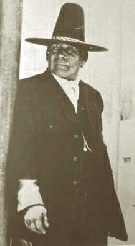
Quest for the Lost Ark

"Covered with gold and surmounted with two golden Cherubim facing each
other, the Ark of the Covenant must have been an awesome object to behold.
But it was what lay inside that made it the holiest - and most powerful -
of religious objects"
The Ark was built to contain the tablets of stone on which God had inscribed
the Ten Commandments and, as such, was believed to wield supernatural powers.
The Bible describes how, blazing with fire and light, it inflicted cancer
like tumors and severe burns on the enemies of Israel, levelled mountains,
stopped rivers and laid waste to whole cities. It was the biblical equivalent
of the atomic bomb.
But, between 900 and 500BC, the Ark vanished from Jerusalem's First Temple
- it's purpose built resting place since King David conquered Palestine and
created Israel around 1000BC. With no mention of the Ark and its whereabouts
made in the scriptures, its 'loss' is regarded as one of the greatest mysteries
of the Bible. But not to the Ethiopians.
Vigilant Guard
The Ethiopian Orthodox Church worships a relic which they believe to be the
true Ark. It rests in the Church of Saint Mary of Zion in the town of Axum.
It is protected by a Guardian - a Coptic priest who never leaves it side,
and never allows any one to see it, not even the Emperors of Ethiopia. The
country's other 20,000 churches keep a replica of the Ark, in a room known
as the Holy of Holies. Indeed, a church without one is considered unconsecrated.
Best selling author Graham Hancock first heard of the legend in 1983, while
writing a book about Ethiopia. He found the earliest account of the Ark coming
to Ethiopia written in a sacred book called the Kebra Nagast , or
the Glory of Kings.
The book tells how the Queen of Sheba conceived King Solomon's child while
on a visit to jerusalem. On her return to Axum, she gave birth to a son,
named Menelik. Some 20 years later, Menelik visited Jerusalem and spent a
year at his fathers court. On his departure, he stole the Ark and carried
it off to Axum.
During his initial visit to Ethiopia in 1983, Hancock made a point of visiting
the chapel in Axum, and asking the Guardian about the legend of the Ark.
"It was brought to Ethiopia, to this sacred city... here it has remained
ever since" the Guardian told Hancock.Could it possibly be true?

Sifting Fact from Fiction
After leaving Axum, Hancock decided to find out if the story had any substance.
His investigation, at first, did not prove promising. Professor Richard
Pankhurst, a leading historian on the area, told Hancock that while the legend
of Solomon and Sheba had an ancient pedigree in Ethiopia, Sheba had almost
certainly come from Arabia, not Ethiopia.
More damming was that Axum did not exist when Menelik was alive. In fact,
it was not founded until the 3rd century BC - about 700 years after his death.
Hancock put his quest on hold, but he remained intrigued by the fact that
there could be a grain of truth in the legend. Seven years later, he resumed
his search for the Ark by going to the primary source of data - the Bible.
Scrolling through a hi-tech computerized version of the Old Testament, he
found more than 200 references to the Ark up to the reign of Solomon (970-931
BC). it was not mentioned again until around 620 BC, when two passages seem
to convey that it was no longer in the First Temple. In other words, there
is a period of slightly more than 300 years during which the relic could
have been spirited away.
Using a powerful 'search and find' tool on the computer, Hancock looked for
words, or sequences of words, that had only ever been mentioned with the
Ark earlier in the text. His reasoning was that any occurences of these phrases
during the three centuries that the relic was not mentioned would constitute
powerful, indirect evidence of it's whereabouts.
By using this technique, Hancock was able to establish that the Ark had probably
remained in the First Temple until at least 701 BC. This meant that it could
only have gone missing in the relatively brief 80-year period between 701
and 620BC.
Ark of Covenant - Profile
Graham Hancock
-
Born in Edenburgh, Scotland, on 2 August 1950.
-
Studied sociology at Durham University.
-
Moved to Nairobi, Kenya, in 1981, where he was East Africa Correspondent
for The Economist.
-
In 1983, he began investigating Ethiopia's claim to possess the Ark of Covenant.
-
His book The Sign and the Seal : A Quest for the Lost Ark of the
Covenant was published in 1992, and went on to become an international
bestseller.

|


























